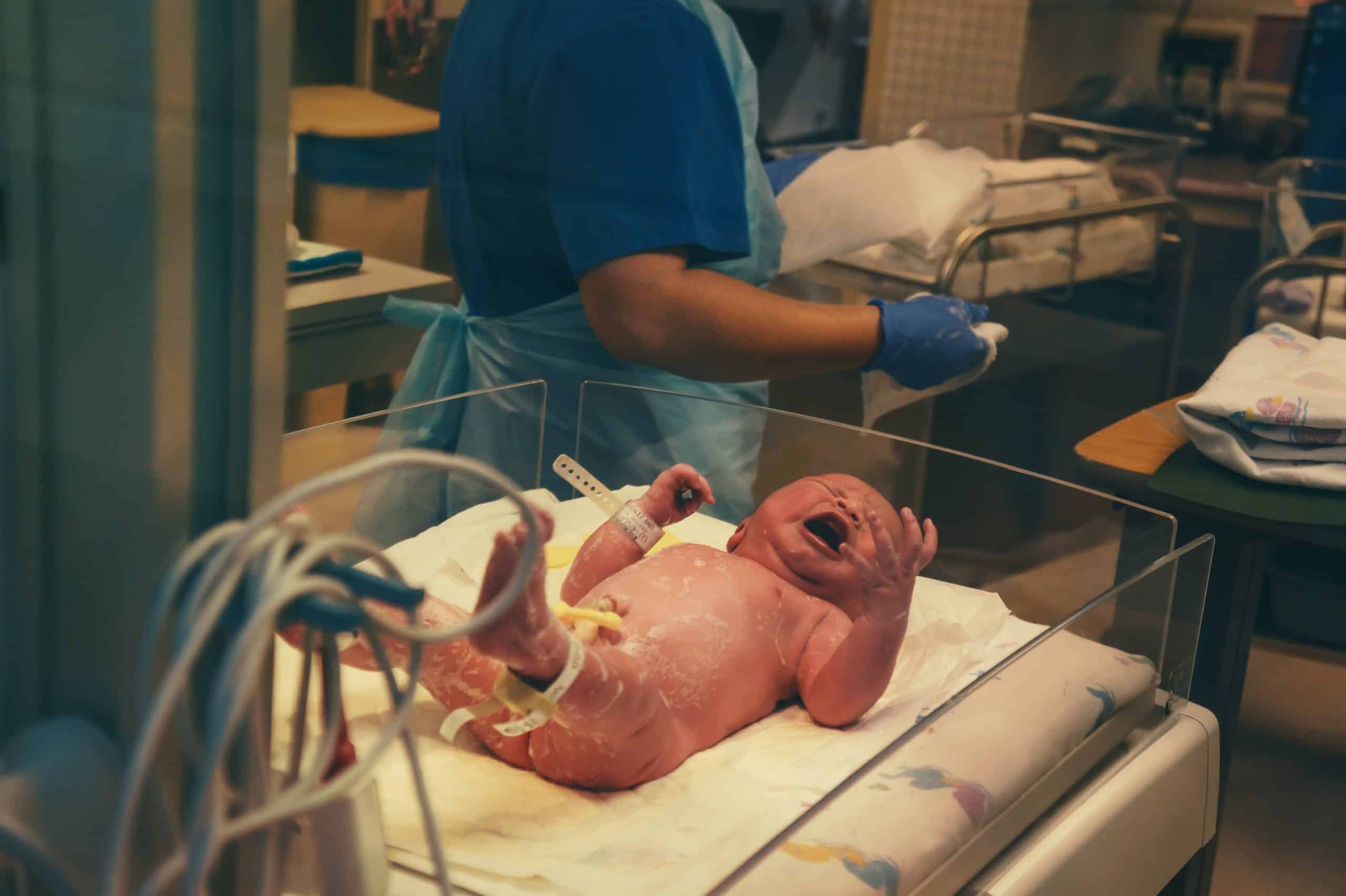Giving birth is one of the hardest, most rewarding things I have ever done. I carried three babies and then welcomed them into the world. Each experience was wildly different: one induction, one short labor and delivery, and one long birth that stalled so many times I thought he’d never arrive. At the same time, in the grand scheme of things, my births were all very simple. They were unique and special for me, but there was nothing extraordinary about them when compared to the huge spectrum of potential birth experiences. I had contractions, I got an epidural, and I pushed until my baby joined the world. Birth is an experience that is different from mom to mom. It’s completely natural and typically follows the same pattern of events, but it can also be unpredictable and unexpected. For new moms, or moms who simply want a different experience from their last, there are seemingly endless birthing decisions to make. Will you have your baby in a hospital or at home? Will you get an epidural or use other methods to manage the pain? Here are the options.
Getting Things Started
Unless you are scheduled for a cesarean section, your body has to go into labor before you can actually give birth. Modern moms are offered the option to wait for spontaneous labor or have their labor induced, typically through the use of a drug called Pitocin.  When it comes to getting things started, there are many benefits to letting nature take its course. It is generally accepted that spontaneous labor is associated with a lower risk of intervention, specifically decreasing the risk of needing a c-section or an epidural, as documented in a study published in The Journal of Reproductive Medicine. Elective induction, meaning induction without a clear medical need for it, is found to increase the risk of needing a c-section, having an epidural, and causing concerning heart rate changes in the unborn child. At the same time, benefits of induction do exist for mothers who are over 41 weeks gestation. For these moms, who have carried longer than typical pregnancies, elective induction actually reduces the risk of a c-section compared to moms who wait for spontaneous labor past 41 weeks, according to a medical data compiled by Stanford-UCSF Evidence-Based Practice Center.
When it comes to getting things started, there are many benefits to letting nature take its course. It is generally accepted that spontaneous labor is associated with a lower risk of intervention, specifically decreasing the risk of needing a c-section or an epidural, as documented in a study published in The Journal of Reproductive Medicine. Elective induction, meaning induction without a clear medical need for it, is found to increase the risk of needing a c-section, having an epidural, and causing concerning heart rate changes in the unborn child. At the same time, benefits of induction do exist for mothers who are over 41 weeks gestation. For these moms, who have carried longer than typical pregnancies, elective induction actually reduces the risk of a c-section compared to moms who wait for spontaneous labor past 41 weeks, according to a medical data compiled by Stanford-UCSF Evidence-Based Practice Center.  Of course, there are also cases when induction is no longer considered elective because the mom or baby’s condition requires an early delivery. In some cases, such a placenta previa, a scheduled c-section is required to protect the baby and the mother’s help, according to James Betoni, a leading high risk maternal fetal medicine OB-GYN Boise, Idaho.
Of course, there are also cases when induction is no longer considered elective because the mom or baby’s condition requires an early delivery. In some cases, such a placenta previa, a scheduled c-section is required to protect the baby and the mother’s help, according to James Betoni, a leading high risk maternal fetal medicine OB-GYN Boise, Idaho.
Does environment matter?
We’ve covered the question of when a mom gives birth, but what about where? Moms can choose between a hospital birth, home birth, or birthing center. Although the popularity of home births has increased over the last decade and a half, most mothers still plan to have their babies in the hospital. Home births accounted for .89 percent of all births in 2012, the last year the Centers for Disease Control and Prevention collected data on this subject, and .39 percent of moms chose a birthing center. It’s difficult to compare the benefits of in-hospital and out-of-hospital births. For instance, a 2015 study published in The New England Journal of Medicine did find differences existed between in-hospital and out-of-hospital births, but they were not only insignificant, the study also noted that negative outcomes of births were very low in both situations. More specifically, fetal death was more likely in an out-of-hospital births, but only slightly, and the difference was not enough to be considered statistically significant. One thing worth noting was that obstetrical intervention, specifically c-sections, were more likely in planned hospital births than in planned home births.  Even so, the choice to deliver a baby at home or in a birthing center is a controversial one. Although the United Kingdom has taken an official stance on the subject, encouraging low-risk mothers to consider home births, the United States is more resistant to the idea. “For low risk women who are properly screened, home birth is a safe option,” says Christina M. Kocis, certified nurse midwife and doctor of nursing practice, director of the Division of Midwifery at Stony Brook University Hospital. “I think we don’t have an infrastructure or a system here that supports that as they do in the UK.”
Even so, the choice to deliver a baby at home or in a birthing center is a controversial one. Although the United Kingdom has taken an official stance on the subject, encouraging low-risk mothers to consider home births, the United States is more resistant to the idea. “For low risk women who are properly screened, home birth is a safe option,” says Christina M. Kocis, certified nurse midwife and doctor of nursing practice, director of the Division of Midwifery at Stony Brook University Hospital. “I think we don’t have an infrastructure or a system here that supports that as they do in the UK.”  She also notes that because the UK supports home births, these births tend to be attended by certified midwives who are actually part of the national healthcare system; this isn’t the case in the United States. Of course, it is possible to find properly trained and licensed midwives in the United States, but mothers should be aware that there are lay midwives practicing here and ensure that their home birth team has received proper licensure. In addition to the choice between hospital, home, and birthing center, there is the choice of water birth or giving birth in bed. Unfortunately, there is not a lot of research available on potential negative outcomes associated with these two choices. One study, published in 2016 in The Journal of Midwifery and Women’s Health, found no risks for babies associated with their mother choosing a water birth but noted that moms might be at an increased risk for genital tract trauma.
She also notes that because the UK supports home births, these births tend to be attended by certified midwives who are actually part of the national healthcare system; this isn’t the case in the United States. Of course, it is possible to find properly trained and licensed midwives in the United States, but mothers should be aware that there are lay midwives practicing here and ensure that their home birth team has received proper licensure. In addition to the choice between hospital, home, and birthing center, there is the choice of water birth or giving birth in bed. Unfortunately, there is not a lot of research available on potential negative outcomes associated with these two choices. One study, published in 2016 in The Journal of Midwifery and Women’s Health, found no risks for babies associated with their mother choosing a water birth but noted that moms might be at an increased risk for genital tract trauma.  Of course, risk factors aren’t the only thing worth considering. For moms who are looking for alternative pain management options, a water birth might be an appropriate choice since it is believed to offer the benefits of added comfort and helping to calm the mother, according to the American Pregnancy Association.
Of course, risk factors aren’t the only thing worth considering. For moms who are looking for alternative pain management options, a water birth might be an appropriate choice since it is believed to offer the benefits of added comfort and helping to calm the mother, according to the American Pregnancy Association.
Drug-Free or Pain-Free?
The next choice moms have to make might be among the most debated of birthing choices. Should mom get an epidural, or should she opt for a birth free of pain medication?  There are some downsides to electing to have an epidural, according to a study published in Obstetrics and Gynecology International. Research suggests that having an epidural is associated with a slower second stage of labor which may increase the likelihood of c-section. And mothers who have an epidural are at an increased risk of an assisted delivery, meaning medical instruments are used during the delivery to remove the baby from the birth canal.
There are some downsides to electing to have an epidural, according to a study published in Obstetrics and Gynecology International. Research suggests that having an epidural is associated with a slower second stage of labor which may increase the likelihood of c-section. And mothers who have an epidural are at an increased risk of an assisted delivery, meaning medical instruments are used during the delivery to remove the baby from the birth canal.  There are no risks associated with giving birth without pain medication, however, as Kocis points out, physiological effects are not the only thing to consider in this decision. “There may be patients who need pain medication who, as a result of using pain medication, may … have a birth that, in retrospect, was either calmer or, in their opinion, may be less traumatic for some women,” she explains. “But the same can hold true for women who get the medication.” This choice is one that is difficult to generalize, according to Kocis, and that seems to be true based on what moms who have experienced either an epidural or a drug-free birth share with HealthyWay.
There are no risks associated with giving birth without pain medication, however, as Kocis points out, physiological effects are not the only thing to consider in this decision. “There may be patients who need pain medication who, as a result of using pain medication, may … have a birth that, in retrospect, was either calmer or, in their opinion, may be less traumatic for some women,” she explains. “But the same can hold true for women who get the medication.” This choice is one that is difficult to generalize, according to Kocis, and that seems to be true based on what moms who have experienced either an epidural or a drug-free birth share with HealthyWay.  “The whole experience was fantastic. I was fortunate to have a quick labor, but I really appreciated being in control of my body,” shares Betsy Larson, a mom of one who opted out of an epidural for her planned hospital birth. “I wasn’t confined like I was concerned I would be with an epidural.”
“The whole experience was fantastic. I was fortunate to have a quick labor, but I really appreciated being in control of my body,” shares Betsy Larson, a mom of one who opted out of an epidural for her planned hospital birth. “I wasn’t confined like I was concerned I would be with an epidural.”  In comparison, Erin Heger, a mom of one who also had a planned hospital birth without an epidural, says that the advantage of being in control and having the support of her doula was great, but it wasn’t worth the pain and exhaustion she experienced. “I will not be doing it again,” she says of her drug-free birth.
In comparison, Erin Heger, a mom of one who also had a planned hospital birth without an epidural, says that the advantage of being in control and having the support of her doula was great, but it wasn’t worth the pain and exhaustion she experienced. “I will not be doing it again,” she says of her drug-free birth.
Laboring Techniques
An epidural isn’t the only method for managing pain during labor. When it comes to laboring techniques, HypnoBirth and the Bradley Method seem to be the most popular among today’s moms. Much of want is known about the benefits of these laboring techniques is anecdotal, according to a comparison of the two written in The Journal of Perinatal Education.  However, this research does make it clear that each of these methods holds benefits for moms with specific desires and circumstances. HypnoBirth, for instance, is heavily focused on pain management through self-hypnosis, making it a great option for women committed to managing their pain themselves or who are without a supportive partner.
However, this research does make it clear that each of these methods holds benefits for moms with specific desires and circumstances. HypnoBirth, for instance, is heavily focused on pain management through self-hypnosis, making it a great option for women committed to managing their pain themselves or who are without a supportive partner.  In comparison, the Bradley Method is all about the partner, teaching the significant other to be the laboring mother’s coach through the labor and delivery. Each of these methods can be incredibly helpful to laboring moms, according to Kocis, but much of the success is dependent on the mother (and her partner) and their ability to commit to really learning the practices of the technique. Ultimately, when it comes to making choices about how and where a mom will labor, the choice is all about her specific medical needs and her preferences. What one mom wants or needs may be vastly different from another mom’s hope for her birth, and it is important to spend time reflecting on that before making a decision. Most importantly, moms should be sure they are educated so they can make good choices for themselves and their baby.
In comparison, the Bradley Method is all about the partner, teaching the significant other to be the laboring mother’s coach through the labor and delivery. Each of these methods can be incredibly helpful to laboring moms, according to Kocis, but much of the success is dependent on the mother (and her partner) and their ability to commit to really learning the practices of the technique. Ultimately, when it comes to making choices about how and where a mom will labor, the choice is all about her specific medical needs and her preferences. What one mom wants or needs may be vastly different from another mom’s hope for her birth, and it is important to spend time reflecting on that before making a decision. Most importantly, moms should be sure they are educated so they can make good choices for themselves and their baby.
Basics for the complex:
The way you give birth is NOT a competition. Natural, C-section, or Epidural does not define you as a mom. A mom is a mom.— Tanya Sparkles (@Tanya__Sparkles) January 22, 2018
“There is no one answer,” explains Betoni. “Every patient is different and every story is different. When there is an option, as long as the patients are educated, the mom should have a say.”



